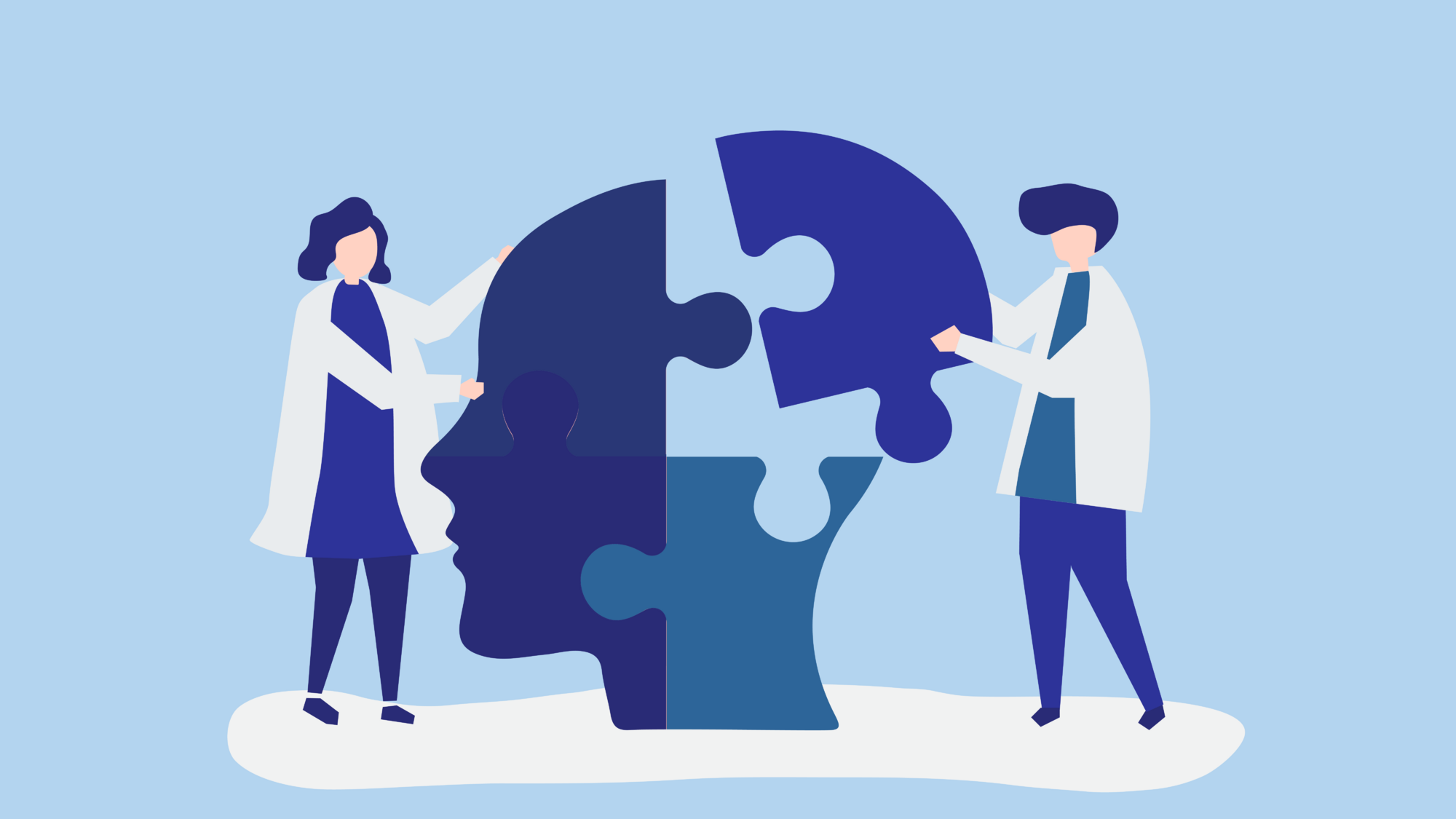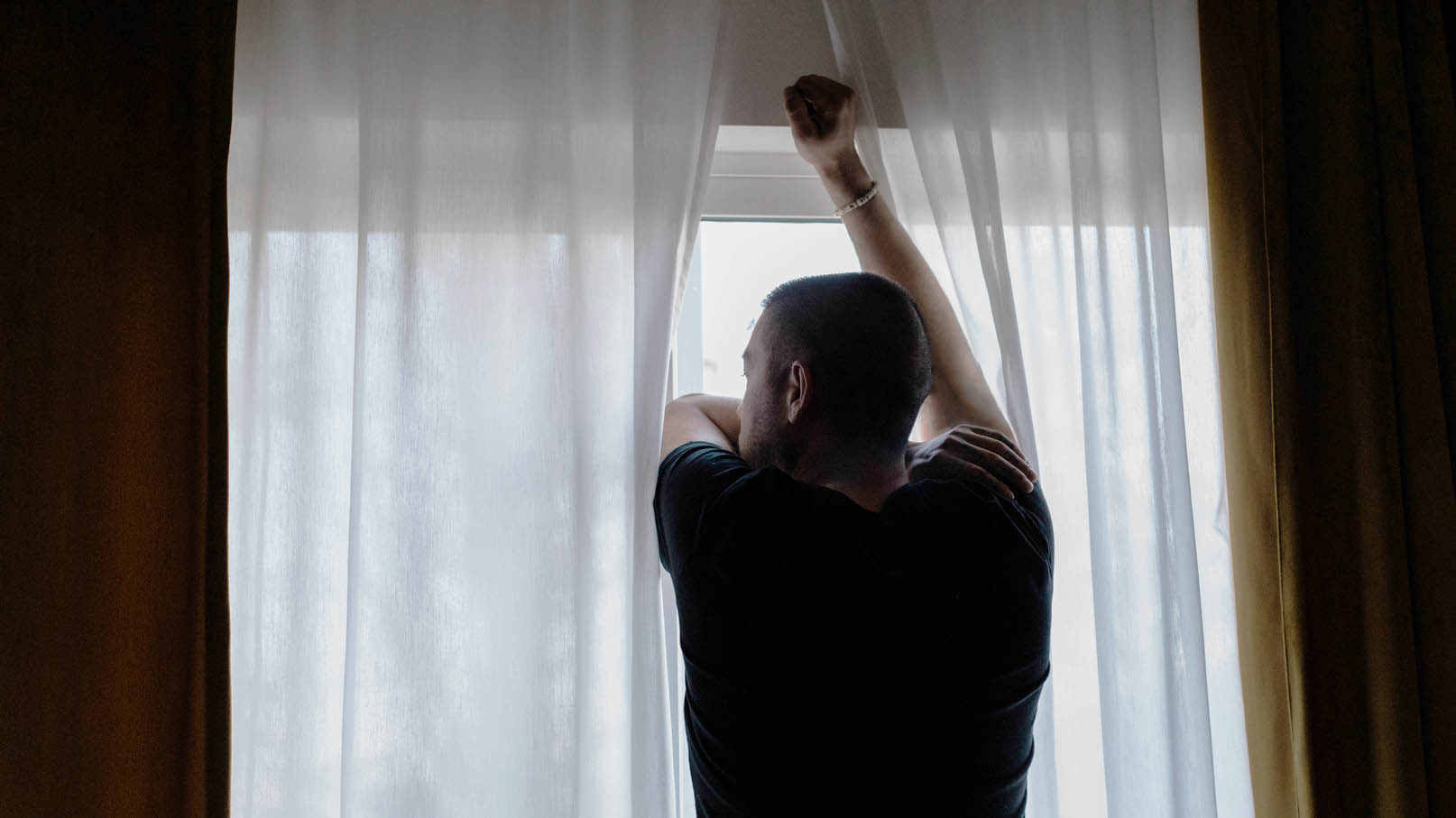1. What is mental Health?
When people talk about their health, it's often about all sorts of physical ailments. Their blood pressure is too high. Their stomach is bothering them. Or their back hurts. But in all of this, a large part of their health is often left out: their mental health. According to the WHO, mental health is a state of well-being in which a person can realize their full potential, cope with the normal stresses of life, work productively, and contribute to their community.
Mental health forms the foundation upon which we can build and shape our lives. Unlike physical ailments, however, our psychological well-being is often difficult to describe. Is an intrusive thought simply a legitimate concern, a part of one's character, or already a sign of mental illness?
Furthermore, the strict separation of body and mind is misleading. It's not for nothing that our hearts beat faster when we watch an action movie. Many physical symptoms are therefore caused or at least influenced by the psyche. Likewise, a persistent or serious physical illness has a strong impact on our mental health.
1.1. What is normal?
A large part of our sense of happiness is based solely on our genes. Therefore, there is no single "normal" that applies equally to everyone. There will always be people who are, on average, happier than others. The good news is: A large part of this can be influenced by our own behavior and our environment.
So every day presents a new opportunity to give your own happiness a little boost. In any case, it's completely normal to have bad days now and then. Of course, there are unforeseeable life events—such as deaths among friends or other dramatic experiences—where the joy of life is diminished for an extended period. This, too, is completely normal.
1.2. When is a mental Illness present?
Mental illnesses are common and can affect anyone. Therefore, no one should feel alone with their symptoms. On the contrary: In cases of severe or persistent symptoms—as with physical illnesses—it is important to seek a personal consultation with a professional. This way, doctors or psychotherapists can ensure that the best solution can be found for each individual at an early stage. Doctors and psychotherapists then help to determine whether the suffering is severe or has been ongoing for a longer period of time. In doing so, they consider not only the affected person themselves, but also their environment and social network. Professional outside help is often an important first step toward effective treatment and improvement.
The path to a diagnosis requires contact with doctors or psychotherapists. In a conversation, all major complaints and the patient's life situation are then discussed. Certain psychological symptoms often occur together. If these symptoms persist for a certain period of time and additional examinations have been conducted, a diagnosis can be made based on an international classification.
Good to know: Of course, classifications (with specific criteria) are only attempts to better define mental illnesses. These classifications are never perfect and, like everything in science, are subject to constant change. The advantage, however, is that mental illness can be identified and treated early and equally by every practitioner.
1.3. Strengthening Resilience: The Secret to mental Health
There are things that can make the occurrence of mental illness less likely. The term "resilience" describes a person's resilience—that is, the ability to cope with stress and negative experiences.
The following factors can increase a person’s resilience to mental illness:

Certain factors can have a negative impact on a person's mental health. These include pre-existing mental health conditions, alcohol or drug abuse, traumatic experiences, extremely stressful life events, marital conflicts and divorce, the death or illness of loved ones, bullying and hostility, experiences of abuse, neglect, and poverty.
However, it is very important to realize that none of these factors alone determines whether a person develops a mental illness or not. Thus, strengthening factors can certainly prevail, even when there are also negative influences in life. After all, people have an incredible ability to overcome adversity and draw strength from their strengths.
2. What mental Illnesses exist? – An Overview of the List
Many people wonder why it even makes sense to label something with a diagnosis and to describe certain mental conditions as mental illnesses. One important reason is that there are now good treatment options for most mental illnesses. However, without diagnosis and treatment, people can be left alone for an unnecessarily long time. It is important to instead reduce the stigma surrounding mental illnesses and to realize that everyone can be affected at some point in their life.
There are also a number of reasons why people with mental illnesses shouldn't be pigeonholed. The most obvious is that the many groups of mental illnesses are fundamentally different. The challenges that those affected face on a daily basis could hardly be more diverse.
Here is a list of different groups of mental illnesses:
2.1. Depression, Mania, and bipolar Disorder
All three are considered "affective disorders," in which mood and motivation are primarily altered.
In depression, these are typically reduced. Those affected also often find it difficult to maintain interest in the things they normally enjoy. Other symptoms such as reduced concentration or attention, reduced self-esteem and self-confidence, or feelings of guilt, lack of appetite, sleep problems, and suicidal thoughts can also occur. In mania, however, people display an elevated mood, even to the point of detachment and mild irritability. If depressive and manic episodes alternate, it is referred to as bipolar disorder.
Good to know: Depressive symptoms that occur every year during the fall and winter months are referred to as seasonal affective disorder, or winter depression for short. It is often accompanied by weight gain and an increased need for sleep. Light therapy can be very helpful in this case.
2.2. Dependence and Addiction
Dependence and addiction can arise from a variety of substances. The most common include alcohol, nicotine, cannabis, and certain medications. People can be both psychologically and physically dependent on substances. Addiction is therefore not a personal choice. Rather, genes have been shown to play a major role.
With alcohol, there are several criteria that can be used to determine whether a person is addicted. Typically, at least three of these criteria must be met for more than a year:
- Is there a strong urge to drink alcohol that cannot be avoided?
- Do physical symptoms such as tremors or sweating occur when not drinking for a long time?
- Do increasingly large amounts need to be consumed to experience the same effect?
- Is the person unable to stop after small amounts?
- Does the person continue to drink despite having experienced negative consequences in their life?
- Are other interests and responsibilities being neglected because of drinking?
2.3. Brain Damage and Dementia
With its ability to think, the brain occupies a special position among organs. On the other hand, it can be exposed to external and internal damage just like any other organ. These include disease processes such as tumors or inflammation, injuries, the damaging effects of drugs or medications, reduced blood flow through the cardiovascular system, metabolic effects of liver and kidney disease, or age-related loss of nerve cells.
All of these causes can cause temporary or permanent damage to brain tissue and cells. The associated effects on a person's mental health are not uncommon.
2.4. Psychotic Illnesses: Schizophrenia and others
There are mental illnesses in which a person's entire experience is abnormally altered—and often difficult to understand for outsiders. This affects perception, thinking, feelings, and all other areas that make up the human psyche.
The best-known clinical picture in this group is schizophrenia. Symptoms can include, for example, beliefs that do not correspond to reality or the feeling of being subjected to external thoughts or to an influence on one's will. However, even here, there are many subtypes. Therefore, for an accurate diagnosis, certain criteria must persist for a minimum period of time. This can cause significant distress for those affected and also cause significant difficulties for others to cope with.
2.5. Neurotic Disorders: Anxiety, Obsession, and psychosomatic Disorders
Everyone experiences anxiety, and in many situations, it is entirely appropriate as a natural reaction. But it can be considered a disease if the fears appear unfounded and exaggerated, even to those affected. Anxiety can exist as a persistent, difficult-to-grasp condition, be specific to certain situations, or even be accompanied by panic attacks.
It is similar with compulsions. Those affected are usually aware that they do not pursue a higher purpose. Nevertheless, a compulsion cannot simply be suppressed. They can occur in the form of thoughts, impulses, or actions. Here, too, treatment is only necessary if the suffering or everyday limitations are severe.
Furthermore, the human psyche is closely linked to the body. On the one hand, many physical complaints can be triggered entirely by the psyche. On the other hand, physical illnesses can also be significantly influenced by the psyche. Even in purely physical complaints, the psyche should always be taken into account.
2.6. Personality Disorders
Personality disorders describe behavioral patterns that deviate significantly from accepted social norms and are deeply rooted in a person's character. Just because a person has certain distinctive traits does not necessarily mean they have a personality disorder. Ultimately, it depends on the severity and thus the following questions: Does the trait lead to conflict with others or to personal distress?
A personality disorder is not something that suddenly appears and disappears quickly. Therefore, it is always important to determine whether the abnormal trait has been present since adolescence.
2.7. Eating, sleeping, and sexual Disorders
The human psyche can also have a significant impact on eating, sleeping, or sexual behavior.
For example, in anorexia, there is a pronounced concern about being overweight, despite being measurably underweight. Those affected by bulimia, on the other hand, are of normal weight but alternate cravings and binge eating with weight-loss measures such as vomiting, periods of fasting, or taking laxatives.
Sleep disorders can be associated with reduced sleep quality, as well as with too much or too little sleep. The most common problems are falling asleep or staying asleep. Here, too, there is a reciprocal effect: Poor sleep affects the psyche. But the psyche also influences sleep.
Sexual dysfunction is common and can have both physical and psychological causes. Here, too, it is only considered a disease if the affected person experiences distress.
3. What are the psychological Effects of Loneliness?
Some people prefer being alone more than others. On the other hand, no one enjoys being lonely.. Because being alone and being lonely are two different things. How much time someone spends alone only says a limited amount about how the person feels about it. What matters is the extent to which the person wanted to be alone during that time.
Unlike being alone, loneliness is always a negative feeling – especially if it persists over a longer period of time. And people can also be lonely in company. It always depends on how connected a person feels to those around them. A close friendship is often more important than 20 casual acquaintances.
The effects of loneliness on mental and physical health have now been well researched. These include:
- Hospital admissions in old age – In older people, loneliness leads to increased admissions to hospitals, nursing homes, or other facilities.
- Life expectancy – Loneliness in old age leads to a shorter life expectancy on average.
- Mental abilities – Loneliness in old age increases the risk of developing dementia.
- Mood and well-being – Loneliness increases the risk of depression, and depression increases the risk of loneliness.
- Risk of suicide – This is increased by loneliness in both adolescents and adults.
- Pain perception – Loneliness has been proven to increase the perception of pain.
- Fatigue and exhaustion – Both are on average higher in lonely people.
- Sleep quality – Loneliness impairs sleep duration and quality.
- High blood pressure – Lonely people are on average more likely to have high blood pressure.
- Stress hormones – The stress hormone cortisol is on average elevated in people who suffer from loneliness.
Humans are social beings and were evolved to live in communities. The most effective remedy for loneliness is therefore close, trusting relationships. Large, long-term studies impressively demonstrate the extent to which good relationships not only have a positive impact on overall life satisfaction, but also on mental and physical health.
4. How Work can affect the Psyche
Today, the 40-hour workweek is considered normal in most Western countries. However, nothing about it is set in stone. Neither more nor less work. In China, for example, there is the "996 system" – working from 9 a.m. to 9 p.m., 6 days a week. During the Industrial Revolution, even workdays of 16 hours or more were the norm. Scientists, however, assume that originally, as hunter-gatherers, humans spent only a fraction of their day "working." The number of daily working hours is therefore always arbitrarily chosen and more a result of the current zeitgeist.
Work presents both opportunities and risks for a person's mental health. On the one hand, work can provide meaning and fulfillment, create space for community, guarantee a secure livelihood, and provide recognition. But on the other hand, work can also alienate people from meaningful values and overload them physically and mentally. The lack of work can also become a major psychological challenge if people remain unemployed for years without their consent.
4.1. Digital Work: The Home Office and its Pitfalls
Digitalization has given people completely new ways of working. The home office is one of these developments. Its advantages are manifold. These include avoiding long commutes, fewer distractions from colleagues, a personal work environment, and more flexible working hours. The list is long.
However, these same factors also present pitfalls. After all, the commute can also involve daily exercise, which is important for health – including mental health. Colleagues, in turn, provide regular social contact. And if the relationship is good, this enables further supportive relationships in life.
While the home work environment may be personal, it can sometimes be more difficult to clearly separate work and leisure time. Furthermore, inadequate home office design can quickly lead to poor posture and pain, which can then also have a negative impact on the psyche. People who work from home are also more likely to work more than less and not to draw a clear line in the day after work. This is problematic, as long working hours have been shown to increase the risk of depression.
4.2. Burnout and existential Anxiety
Almost everyone experiences phases of overwork and exhaustion during their professional life. This is completely normal and doesn't necessarily have to be a cause for concern. However, it's important to get to the bottom of the issue and seek help – especially in cases of severe or long-lasting symptoms:
Because so-called burnout is often the result of mild, moderate, or severe depression, which can have far more triggers than stress-related overload alone. Here, too, it's important to break down the social stigma surrounding depression. With the correct diagnosis, those affected can then find appropriate treatment more quickly and thus a way back to their old lives.
Of course, there's no question that work—including excessive demands and sustained stress—can be detrimental to mental health. Long daily and weekly working hours, in particular, increase the risk of depression and sleep disorders. Therefore, it's very helpful to ensure a good work-life balance for yourself and others. Unemployment and fear of job loss can also have a negative impact on mental health. This can become a mental burden, especially when people have financial fears or are unwillingly unemployed for an extended period.
4.3 Mental Illnesses in old Age
Mental illnesses are among the most significant health problems in old age. In addition to chronic physical illnesses, mental and neurodegenerative disorders – especially dementia – also become more common with age. These disorders are among the most common causes of limitations in independence and are closely linked to a growing need for care.
Data show that health limitations and multiple illnesses increase with age. At the same time, the demands on medical care and prevention are also changing. Early detection and treatment of mental illnesses in older people is therefore crucial – not only to improve quality of life but also to relieve the burden on care structures.
Social factors such as loneliness or limited mobility also play a role in mental well-being in old age. Preventive approaches and integrated care models are becoming increasingly important in public health research.
5. Are mental Illnesses hereditary?
Yes, mental illnesses such as schizophrenia and bipolar disorder can occur more frequently in families – this is partly due to genetic causes. An international team of researchers, including German universities, has discovered that certain regions in the human genome increase the risk of such disorders. A total of eleven genetic regions were identified that are associated with schizophrenia and bipolar disorder – some of which were previously unknown. What's particularly exciting is that some of these genetic risk factors affect both disorders simultaneously. This shows that there are common biological foundations.
As previously mentioned, a genetic predisposition does not automatically mean that someone will actually develop the disease. Environmental factors such as stress, trauma, or drug use also play an important role in its development. Research assumes that many genes, along with external influences, influence the risk. This explains why not all family members are equally affected – even if a genetic predisposition is present. In short: Yes, mental illnesses are partly hereditary – but they usually arise from the interaction of genes and the environment.

Einige Maßnahmen haben sich aber für alle Menschen als hilfreich erwiesen. Hierzu zählen [3, 11, 67-80]:
6. How can you improve your mental Health?
6.1. Tips for mental Health
Fortunately, everyone can have a significant impact on their mental health. Of course, everyone brings their own unique characteristics and experiences. What stresses one person may be quite pleasant for another. Likewise, the things that benefit some people and not others vary.
However, some measures have proven helpful for everyone. These include:
- Daily exercise – This has been proven to better sleep, reduce stress and anxiety, and lower the risk of depression.
- Balanced diet – A diet rich in vegetables, fruit, fiber, nuts, and legumes, and avoiding excessive calories, processed foods, high salt or sugar content, and saturated fat, is beneficial for health.
- Adequate sleep – Sleep quality has a strong impact on mental health. Therefore, you should always make sure to schedule regular bedtimes and get enough sleep.
- Relaxation and enjoyable activities – Things like mindfulness training, yoga, or meditation can reduce stress and have been proven to reduce anxiety and depression. However, everyone should try out what works for them. The same applies to enjoyable activities in everyday life.
- Promote positive relationships – Regular, trusting relationships that are perceived as pleasant are healthy (whether with a partner, friends, neighbors, or colleagues).
- Reduce negative relationships – Interpersonal relationships that repeatedly lead to bad moods or unpleasant conflicts are detrimental to one's health and should be resolved or avoided.
- Manage your financial situation – Fears about one's existence have a very negative impact on one's health. If possible, countermeasures should be taken. A non-profit debt counseling service can help.
- Minimize addictive substances – Excessive consumption of alcohol and other addictive substances has a proven negative impact on mental health.
- Daily exposure to nature – Living in a green environment or at least regularly spending time in nature has a positive effect on mental health.
- Reduce noise – Constant noise in everyday life increases people's stress levels and should be avoided.
6.2. When is professional Help needed?
The question of when professional help is needed for mental health problems always depends on the situation and the individual. As a rule of thumb, if in doubt, it's better to consult a professional sooner rather than later. A conversation with your family doctor can provide an initial exchange, discuss appropriate next steps, and even provide a referral to a psychological psychotherapist or psychiatrist.
Whether someone needs medications that affect their mental health (so-called psychotropic drugs), psychotherapy, or both can only be assessed after a consultation with a professional. As explained above, a correct diagnosis is always crucial before initiating treatment.
Turning to people in your own circle of friends and professionals in a timely manner regarding your mental health problems is always the most important step on the path to recovery.
The contents of this article reflect the current scientific status at the time of publication and were written to the best of our knowledge. Nevertheless, the article does not replace medical advice and diagnosis. If you have any questions, consult your general practitioner.
Originally published on







